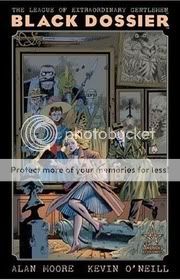The League of Extraordinary Gentlemen: Black Dossier
Alan Moore, writer
Kevin O’Neill, artist
DC/WildStorm/America’s Best Comics, 2007
208 pages, hardcover
$29.99
It occurred to me when reading this latest installment of Moore and O’Neill’s journey through the literature of the fantastic that it’s basically Moore’s version of Earth X. Like that Jim Krueger/Alex Ross exercise in continuity farming, Moore’s overarching narrative scheme is to find a way to connect nearly every character in the history of genre storytelling, from Jehovah to James Bond.
This volume goes further than ever in that direction, revealing that all of the world’s extraordinary gentlemen, supernatural creatures, and so one can trace their origin back to two warring (and occasionally miscegenating) tribes of godlike beings: the Bible’s “Elohim,” which either directly or through their offspring account for the Judeo-Christian God, his ancient pagan counterparts, and the pantheons of Greece, Egypt, and Germany/Scandinavia; and (basically) Lovecraft’s Great Old Ones, whose descendants include pretty much every monster known to man.
The “good” gods have made two notable attempts to bridge the gap between mortal and deity. The first was the Greek Age of Heroes, an experiment in interbreeding that the Gods aborted at Troy when it became apparent that these powerful people were pretty much all sociopathic killing machines. The second, as it turns out, was the creation of the original League of Extraordinary Gentlemen in Shakespeare’s time; here, the Elizabethan Age has been recast as the reign of Gloriana, England’s Fairie Queen, whose assemblage of folks like Prospero and Orlando to “guard the Realm” was really just a cover for forming a group that could successfully liaise between the natural and supernatural worlds. (At least I’m pretty sure that’s the gist.) Meanwhile your friend and mine Cthulhu and his chums keep trying to pop in and devour our souls, the prevention of which – along with thwarting mad scientists, guarding against invasions by rival species, and fucking – has been one of the various Leagues’ primary occupations ever since.
All of this information is contained in the titular dossier. The story takes place in the 1950s, where Mina Murray and Allan Quartermain are harried by elements of the rump Party dictatorship (yep, from 1984, though here the regime doesn’t seem to have lasted much longer than 1954) as they attempt to transport this stolen file to a person or persons unknown for reasons unknown. Both the prime mover and his motive turn out to be McGuffins of a sort, though; the main trick of the story is that all this business of constructing a Grand Unifying Theory of Genre Lit is presented in a series of pointedly dis-unified comics and prose pastiches, including faux-Shakespeare, a Beat novel by Sal Paradyse, a Tijuana Bible, a Jeeves vs. Cthulhu story (maybe my favorite), Crowleyana, boys’ adventure comics, and so on. I think it’s one of Moore’s cleverest conceits in ages, and gives O’Neill, letterer Todd Klein at all a chance to go absolutely buckwild. It’s fourth-wall-breaking fun.
It’s also completely impenetrable from time to time unless you come in with the requisite encyclopedic knowledge of Moore’s sources. I’m not saying that it’s impossible to get anything out of the book without recognizing every last reference – the moral of the story, and the reason why our heroes are cool and their enemies are bogus, are all quite clear whether you know who Raffles the Gentleman Thief is or not. But Moore is having just as much fun making connections, hiding Easter Eggs, and crafting hardcore continuity porn as any superhero writer, just with a different set of toys, and it’d be foolish to deny that. I did pretty well anytime Yog Sothoth or Conan or Dr. Caligari were on the scene, but at other times I could literally go for pages without catching a single reference. I don’t even necessarily think that Moore should care about this, since I doubt there’s anyone who did catch every reference whose name doesn’t rhyme with “Schmalan Schmoore” and he’s writing this story for maximum mind-blowage rather than optimal legibility. Moreover, the stuff that I got was an absolute hoot, and since I don’t believe that continuity-based storytelling is automatically shallow, I’m not going to make that argument any more here than I would when discussing The Sinestro Corps War. I suppose my point is that the two are more similar than you might think, and that maybe it’s that that makes LoEG books as entertaining as they are, and let’s be up front about it.
Tags: comics, comics reviews, Comics Time, reviews


One Response to Comics Time: The League of Extraordinary Gentlemen: Black Dossier